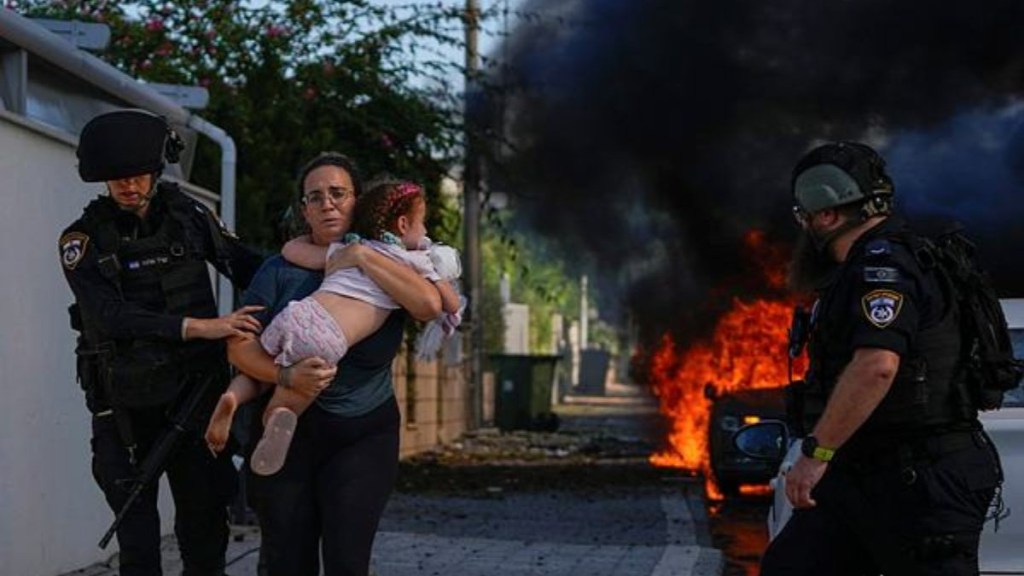A decade ago, a significant battle unfolded, claiming the lives of numerous civilians and over a dozen Israeli soldiers. This harrowing event serves as a foreshadowing of the potential combat scenarios that may arise as Israeli forces prepare to enter Gaza. Their mission: to hold Hamas accountable for its recent aggressive actions in southern Israel.
On July 19, 2014, the world witnessed the third war between Israel and Hamas. The focal point of the conflict was Shijaiyah, a densely populated neighbourhood within Gaza City. The Israeli army deemed this area a “terrorist fortress,” riddled with tunnels, rocket launchers, and deadly traps.
This critical battle occurred on the third day of a ground offensive, following a ten-day aerial campaign. Like the situation today, Palestinian civilians had been urged to evacuate the area, but many chose to remain, influenced by Hamas or driven by a lack of alternative options.
The current scenario is reminiscent of that past conflict. Israel has positioned its infantry and armoured units along the Gaza Strip’s border, issuing a 24-hour evacuation notice to Gazans. This impending ground assault is in response to what Israel perceives as the deadliest terrorist attack in its history.
Should the Israeli forces proceed into Gaza; we may witness one of the most intense and lethal urban warfare scenarios in recent memory. Gaza is one of the most densely populated regions globally, with two million people crammed into a mere 365 square kilometres. This equates to 5,500 individuals per square kilometre, a stark contrast to Israel’s 400.
The narrow roads and alleyways of the Gaza Strip are ill-suited for conventional tanks and armoured vehicles. Attackers can exploit the numerous nooks and crannies of tall, closely-packed buildings to launch anti-tank guided missiles (ATGMs). The potential for entrenched fighting, building-to-building battles, close-quarter combat (CQB), and even hand-to-hand combat is exceptionally high if Israeli forces enter Gaza Strip.
This impending conflict will add to the list of urban warfare incidents, joining the likes of Ukraine, the Taliban’s takeover of Afghanistan, key battles in Syria, and the Battle of Mosul in Iraq in 2016-17.
Urban Warfare and Its Ramifications for the Anticipated Israeli Ground Operation in Gaza Strip
Urban Offensives in Syria and Iraq:
Urban offensives have caused eight times more civilian casualties in four governorates in Iraq and Syria between March 2017 and July 2018 compared to other conflict zones, as per the International Committee of the Red Cross. The devastation wrought by urban warfare leads to a rapid increase in casualties, both due to the direct fighting and its cascading consequences.
Urban warfare is a multidimensional, complex form of warfare, as highlighted by Iran’s ‘Quarterly Journal of Strategic Knowledge Interdisciplinary Studies.’ The experiences in Syria underscore its complexity, high human toll, and profound geopolitical implications, as noted by Iranian scholars Abol Hasan Kabiri and Alireza Saadat Raad.
Lessons from the Ukraine Conflict:
The Ukraine conflict demonstrates the effectiveness of small anti-tank teams against armoured formations. These agile units have excelled in navigating urban terrain to target the lightly armoured roofs of Russian tanks. This strategy highlights the essential need for infantry and engineers working in tandem with tanks in urban warfare. Russian armoured forces’ foray into urban environments without infantry support has left them vulnerable to Ukrainian forces armed with anti-tank weapons. This echoes past failures in Chechnya and Afghanistan, as observed in the report ‘The School of Street Fighting: Tactical Urban Lessons From Ukraine’ by Benjamin Phocas and Jayson Geroux.
Current Situation in Gaza Strip:
The Israeli ground operation is further complicated by the alleged holding of around 150 Israeli, foreign, and dual-national hostages by Hamas. The Israeli army has advised Gaza City residents to relocate to the area south of the Wadi Gaza, just below the city within the 40 km-long territory.
The Israel Defence Forces (IDF) continue their significant operations within Gaza City while making concerted efforts to minimize harm to civilians. Hamas militants are believed to be hiding in tunnels beneath houses and inside buildings densely populated with innocent civilians.
Gaza’s two million residents find themselves grappling with the fifth war in 15 years, compounded by an existing land, air, and sea blockade since 2006. This siege, which shows no sign of ending until hostages are freed, has resulted in severe shortages of water, food, and power. Hamas has issued threats of harming captives if Israel targets Gaza’s civilian areas without prior warning. The United States remains steadfast in its support of Israel in its campaign against Hamas.
The United Nations Security Council on Monday (Oct 16, 2023) recently rejected a Russian resolution addressing the escalating violence in the Middle East. This decision came as Israel prepared for a ground assault on the Gaza Strip after air and artillery strikes claimed the lives of approximately 2,750 people. These events occurred concurrently with President Joe Biden’s visit to Israel, a visit intended to balance support for a key ally with calls for restraint in Gaza operations.
In conclusion, the Israel-Hamas conflict intensifies the likelihood of urban warfare in one of the most densely populated regions in the world. This situation echoes the challenges witnessed in past urban offensives in Syria, Iraq, and Ukraine. The consequences of these conflicts extend far beyond the battleground, affecting civilians and shaping geopolitical landscapes. Gaza’s residents endure the burdens of ongoing conflict, adding another chapter to the region’s tumultuous history. As the world watches, the United Nations grapples with the complexities of international diplomacy at a critical juncture in its history.
